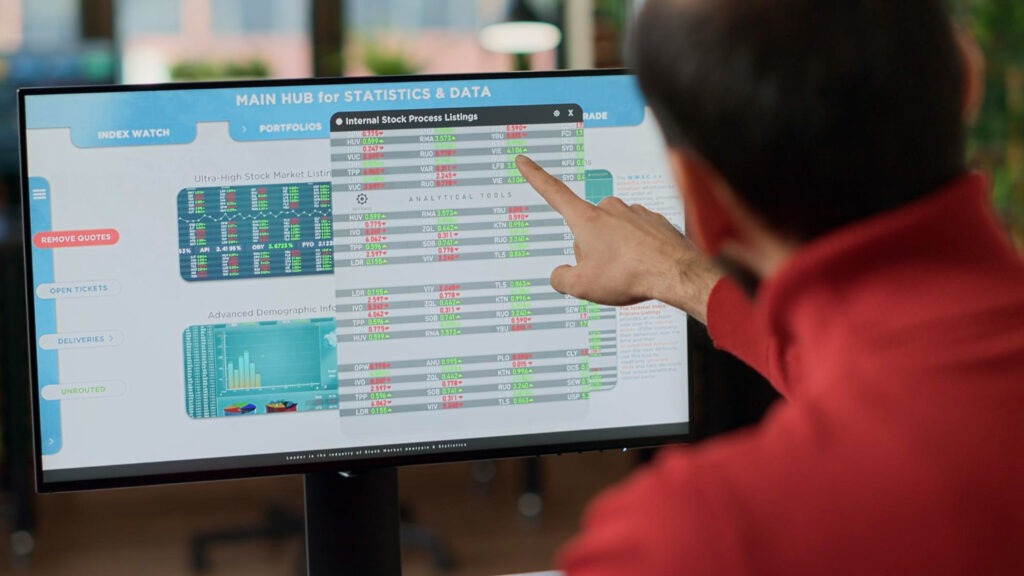About Chronos Trading Limited

With a calm assurance that befits measured ambition rather than ostentatious disruption, Chronos Trading Limited has made its debut in the fintech space. Established on the basis of a particularly inventive algorithmic trading model called The Chronos Strategy, the company has already succeeded in attracting the interest of significant figures in the technology and investment industries. By focusing only on the S&P 500, it aims to reach a highly transparent and liquid market that is conducive to the kind of AI-driven, low-leverage investing strategies that institutional investors are increasingly choosing.
Chronos Trading Limited has been strategically positioned as a Special Purpose Vehicle, an agile setup that enables it to scale quickly while maintaining stringent risk controls, and is supported by a sizeable £2.2 million capital injection from SA Group. The company’s trading strategy, which has already produced an incredibly evident return of 118% in 2022, deploys a small portion of its capital at any given time rather than depending on speculative wagers. This was accomplished without using leverage, demonstrating the company’s careful attention to capital preservation. Chronos has established its reputation by moving precisely rather than hurriedly, much like a chess grandmaster who plans ten moves ahead.
Chronos aims to increase its market presence and capital base through institutional cooperation and strategic alliances. Its leadership, who have worked in regulated finance for decades, knows that consistent returns and open operations are what build long-term trust, not showmanship. Stuart Anderson’s vision through SA Group provides funding and legitimacy to the company’s ambitious expansion, while Jon Hammond’s 25-year trading experience serves as the initiative’s steady hand.
The way Chronos blends adaptive intelligence with disciplined asset management is what makes it so innovative. The strategy’s capacity for real-time learning, adaptation, and optimization is remarkably comparable to that of a swarm of bees reacting to environmental changes—coordinated, innate, and intensely hive-protective. The hive in this instance is investor capital, which is protected by a methodology that moves precisely rather than overextending itself.
Chronos Trading Limited is poised to become a major player in AI-driven finance over the course of the upcoming year. Its capacity to obtain licenses in important international jurisdictions and draw in institutional funding depends not on tricks but rather on the obvious benefit of a system that has already shown itself in actual market situations. Its structure is significantly better than previous fintech models because it places more emphasis on statistically validated results rather than an excessive reliance on speculative tools.
Investors frequently have to choose between growth and preservation during erratic market cycles. A proposition put forth by Chronos avoids that trade-off. The strategy appeals to pension funds, asset managers, and sovereign funds searching for incredibly durable vehicles because it deploys capital in a format with significantly lower risk while retaining upside exposure.
| Attribute | Details |
|---|---|
| Company Name | Chronos Trading Limited |
| Business Model | AI-Driven Fintech SPV (Special Purpose Vehicle) |
| Established | 2023 (Strategy since 2021) |
| Core Strategy | S&P 500 Trading, Zero Leverage, Risk-Adjusted Allocation |
| Return in 2022 | 118% Net of Fees |
| Funding Partner | SA Group (£2.2 Million Capital) |
| Licensing | FCA (UK) and DIFC (UAE) |
| Leadership | Jon Hammond (Chronos), Stuart Anderson (SA Group) |
| Headquarters | London, UK / Las Vegas, USA |
| Target AUM | £100 Million by December 2024 |
| Revenue Target | £20 Million Annually |
| Contact Email | [email protected] |
| Reference | Business Mole Article |
Latest
Forex Trading for Beginners Guide

Once the exclusive domain of bankers in tall buildings, forex trading is now accessible to regular people with smartphones and an inquisitive mind. This market, which is incredibly flexible and unrelentingly global, exchanges over $7.5 trillion every day while silently functioning like a swarm of digital bees—buzzing across platforms, aggregating trades, and reacting immediately to even the smallest changes in the economic environment. Even though what seemed impossible is now remarkably accessible, navigating its complexity still calls for caution, patience, and an acute sense of detail.
Many novices come with the expectation of making quick money, only to discover that forex is more of a marathon than a lottery. Knowledge is the starting point, not luck or leverage. Understanding that currencies trade in pairs, like EUR/USD, and that every trade entails buying one while selling another is the first step in that process. These connections, which are influenced by interest rates, world politics, and economic projections, necessitate a very thorough understanding of how price changes transpire. Thankfully, contemporary platforms provide step-by-step courses, instructional webinars, and demo accounts, all of which are intended to make this challenging learning curve much more manageable.
Beginners transition from speculative trading to well-informed trading by gradually learning how price charts breathe and what candlestick formations whisper. Before ever risking money, novice traders can test out demo accounts, much like a pilot does on a simulator. These resources are especially helpful because they foster competence and confidence, two qualities that are critical for sustained success. Consistency and risk management, not adrenaline-fueled wagers, are the foundation of real gains, no matter how small.
Forex serves as a real-time map of economic sentiment in the context of global volatility. Currency values can change dramatically quickly when central banks adjust interest rates or when public anxiety is sparked by political unpredictability. The forex market is extremely efficient due to its dynamic nature, but it is also emotionally taxing. Learning to ride waves calmly instead of drowning in reactive decisions is a psychological battle that experienced traders say is as fierce as any technical strategy.
The focus on planning is a recurring theme in all successful forex journeys. A trading strategy is more than just a set of guidelines; it serves as a personal compass that helps traders make decisions during both exhilarating highs and discouraging lows. Traders establish habits that are especially advantageous for longevity by avoiding over-leverage, reviewing trade journals, and setting stop-losses. This discipline keeps the focus on making purposeful trades and helps to cut down on noise.
Fintech platforms have significantly increased accessibility over the last ten years, providing tutorials that demystify everything from lot sizes to margin requirements. Furthermore, most seasoned traders advise a cautious approach, even though high leverage ratios can be seductive. On paper, trading with a 50:1 leverage ratio may seem strong, but when the market moves against you, it can be extremely harsh. It’s important to remain grounded, both literally and figuratively.
Machine learning and artificial intelligence have the potential to drastically alter retail forex strategies in the upcoming years. Predictive analytics, configurable bots, and algorithmic signals are already being incorporated into beginner-friendly platforms to aid in decision-making. However, no tool—no matter how sophisticated—can ever fully replace a trader’s time-tested intuition. The future of successful currency trading is determined by the fusion of digital accuracy and human intuition.
| Category | Element | Description | Purpose for Beginners |
|---|---|---|---|
| Getting Started | Minimum Capital | $100–$500 for micro/mini accounts; $1,000+ for standard accounts | Enables low-risk market entry for learning and experimentation |
| Learning Tools | Demo Accounts | Simulated trading environments with virtual funds | Practice strategies without financial risk; test emotional discipline |
| Learning Tools | Educational Platforms | Babypips, Investopedia, IG Academy, Saxo Learn, Udemy courses | Build foundational knowledge; learn market terms and trading mechanics |
| Forex Platforms | Popular Brokers | MetaTrader 4/5, IG, Saxo Bank, Interactive Brokers, OANDA | Provides real-time execution, analytics, and access to global currency pairs |
| Market Basics | Currency Pairs | Examples: EUR/USD, GBP/JPY, USD/CHF, AUD/CAD | Understanding pairs is essential for executing trades and reading price movements |
| Trading Concepts | Pip | Smallest price movement, usually 0.0001 for most pairs | Measures profit/loss in trades and helps assess volatility |
| Trading Concepts | Leverage | Borrowed capital used to amplify trade size (e.g., 50:1) | Increases potential profit but significantly raises risk exposure |
| Trade Types | Long vs Short | Long: buying the base currency; Short: selling it | Allows traders to profit in both rising and falling markets |
| Account Types | Lot Sizes | Standard (100,000 units), Mini (10,000), Micro (1,000), Nano (100) | Determines trade volume; smaller lots offer lower risk entry |
| Strategies | Scalping | Quick trades lasting seconds or minutes for small profits | Best for fast decision-makers using real-time data and technical indicators |
| Strategies | Day Trading | Trades opened and closed within the same day | Reduces overnight risk; ideal for full-time traders |
| Strategies | Swing Trading | Trades held for days or weeks based on trend patterns | Suited for part-time traders who prefer slower pace |
| Strategies | Position Trading | Long-term trades held for weeks, months, or years | Focuses on fundamental analysis and macroeconomic trends |
| Risk Management | Stop-Loss Orders | Predefined price to exit a losing trade | Limits potential losses and protects trading capital |
| Risk Management | Take-Profit Orders | Target price to lock in profits | Automates exits, helping reduce emotion-based decisions |
| Economic Factors | Interest Rates | Set by central banks, influence currency strength | A key driver of price movements and carry trade strategies |
| Economic Factors | Geopolitical Events | War, elections, economic sanctions, etc. | Cause unpredictable volatility; traders monitor news for signals |
| Chart Types | Line Charts | Connects closing prices over time | Good for identifying long-term trends |
| Chart Types | Bar Charts | Shows opening, closing, high, and low prices | Provides detailed insight into price activity per period |
| Chart Types | Candlestick Charts | Color-coded bars that display price movements visually | Offers clearer patterns and reversal signals for decision-making |
| Forex Risks | Market Volatility | Currency values can change rapidly due to global events | Requires discipline, proper risk management, and swift decision-making |
| Forex Risks | Overleveraging | Using too much borrowed capital per trade | Can cause rapid losses and account liquidation |
| Forex Benefits | Liquidity | High trading volume ensures quick entry/exit of trades | Makes forex one of the most flexible and accessible markets globally |
| Forex Benefits | Accessibility | Open 24 hours, 5 days a week, with low entry barriers | Allows part-time or full-time participation regardless of location |
| Security | Regulated Brokers | Examples: IG (UK FCA), OANDA (CFTC), Interactive Brokers | Ensure transparency, fund safety, and compliance with trading standards |
S&P 500 Stocks List

The S&P 500 is a well-tuned economic radar that tracks movements across major sectors with remarkably accurate precision, making it a popular choice for investors looking for a trustworthy pulse check on the U.S. economy. The index represents not only corporate performance but also changing consumer behavior, technological leadership, and global dynamics, much like a mosaic composed of the nation’s most influential businesses. It does more than just list businesses; it simultaneously captures ambition, scale, and resilience.
The S&P 500 is a very good indicator of the strength of American companies, spanning a wide range of sectors from semiconductors and pharmaceuticals to retail giants and fintech innovators. Alongside industry titans like Johnson & Johnson and Coca-Cola, Apple’s technological supremacy, Amazon’s logistical prowess, and Microsoft’s cloud empire create an extraordinarily adaptable combination that emphasizes both creativity and durability. For both novice traders and portfolio managers, it’s like looking at the economic weather forecast: you can see the prevailing winds, the sunshine, and the storm clouds all at once.
Its composition process is especially instructive. The S&P 500 gives an incredibly clear picture of which companies exert the greatest financial gravity by weighting them based on market capitalization. This formula greatly reduces skew and reflects true corporate scale, in contrast to older indexes that only use share prices. The outcome? a more intelligent, user-friendly depiction of market performance that changes dynamically in response to shifting prices.
This index has developed into a reliable indicator over the last ten years, not only for Wall Street insiders but also for international investors, retirement planners, and new fintech platforms. By enabling fractional ownership in industry titans like Tesla, Nvidia, and Meta, exchange-traded funds (ETFs) like SPY have revolutionized the way regular investors obtain exposure. A new generation of tech-savvy shareholders is being fueled by this accessibility, which is surprisingly inexpensive and has significantly improved financial inclusion across demographics.
But the S&P 500’s constant flexibility is what makes it unique. To keep the index active and forward-looking, companies that don’t meet the requirements—whether they be performance, liquidity, or relevance—are replaced. The index committee keeps the roster remarkably in line with the state of the economy by utilizing data analytics and industry forecasting. To keep the momentum going, this recalibration process feels almost surgical, swapping out laggards for leaders.
Many of these businesses are expanding their reach into previously untapped markets and speeding up their growth through strategic alliances. For example, Amazon’s innovative logistics have changed the expectations of delivery around the world. Now that it has revolutionized home entertainment, Netflix is a prime example of agility. Additionally, by automating processes and opening up new possibilities in AI, gaming, and clean energy, tech firms like Nvidia are revolutionizing entire industries.
The performance of the S&P 500 frequently influences sentiment across continents when it comes to international investing. While downturns have an impact on markets across continents, a strong performance can boost markets in Asia and Europe. It is no exaggeration to state that the index is essential to the psychological momentum of global capital markets, which is further enhanced by algorithmic trading and institutional strategies that are closely linked to its swings.
In terms of finances, the figures are equally compelling. The index has 503 tickers as of April 2025, with a combined market value of $47.57 trillion and over $17 trillion in revenue. Not only are these numbers remarkable, but they also demonstrate the concentration of economic power in a time of mega-cap expansion and digital acceleration. The index illustrates how science, semiconductors, and cloud ecosystems are redefining value, with firms like Salesforce, Broadcom, and Eli Lilly currently making inroads up the rankings.
The S&P 500 is a great place to start for people who are new to investing because it provides a pre-made road map for comprehending market dynamics and building long-term wealth. When used regularly, it’s a tool that promotes discipline, draws attention to sectoral changes, and helps people make well-informed decisions. Even people with low levels of financial literacy can participate in it in a meaningful way thanks to the integration of investing apps and educational platforms.
The S&P 500 will likely undergo particularly creative changes in the upcoming years as digital transformation quickens and ESG (Environmental, Social, and Governance) regulations become more stringent. Companies that prioritize blockchain security, AI governance, and green tech may soon be included, providing investors with a portfolio that looks ahead and is based on sustainable returns. Keeping a close eye on it is becoming more than just a habit for finance professionals; it’s becoming a necessary skill for navigating an economy that is becoming more and more data-driven.
| Company | Ticker | Sector | Market Cap (USD) | Stock Price | Revenue (USD) | P/E Ratio | EPS | Dividend Yield | Analyst Rating |
|---|---|---|---|---|---|---|---|---|---|
| Apple Inc. | AAPL | Technology | 2.96T | $196.98 | $395.76B | 31.31 | 6.29 | 0.51% | Buy |
| Microsoft Corp. | MSFT | Technology | 2.73T | $367.78 | $261.80B | 29.62 | 12.42 | 0.86% | Strong Buy |
| NVIDIA Corp. | NVDA | Technology | 2.48T | $101.49 | $130.50B | 34.53 | 2.94 | 0.04% | Strong Buy |
| Amazon.com Inc. | AMZN | Retail | 1.83T | $172.61 | $637.96B | 31.26 | 5.52 | 0.00% | Strong Buy |
| Alphabet Inc. (Class A) | GOOGL | Technology | 1.84T | $151.16 | $350.02B | 18.79 | 8.05 | 0.53% | Strong Buy |
| Meta Platforms Inc. | META | Technology | 1.27T | $501.48 | $164.50B | 20.96 | 23.92 | 0.40% | Strong Buy |
| Berkshire Hathaway | BRK.B | Finance | 1.12T | $518.21 | $371.43B | 12.55 | 41.28 | 0.00% | Buy |
| Tesla Inc. | TSLA | Consumer Durables | 776.37B | $241.37 | $97.69B | 118.42 | 2.04 | 0.00% | Buy |
| UnitedHealth Group | UNH | Healthcare | 415.38B | $454.11 | $410.06B | 18.98 | 23.92 | 1.85% | Strong Buy |
| JPMorgan Chase & Co. | JPM | Finance | 645.54B | $231.96 | $168.73B | 11.39 | 20.37 | 2.07% | Buy |
S&P 500 Companies by Market Cap

Starting with the top S&P 500 companies by market capitalization, a significant change has occurred at the heart of the U.S. stock market in recent months. Similar to chess grandmasters ruling the board, these powerful companies—Apple, Microsoft, and Nvidia—have a significant impact on the economy rather than just being involved in it. Their influence on everything from global supply chains to investor sentiment is remarkably comparable to how a few key notes define a whole symphony.
These businesses have grown to become not only well-known brands but also independent financial institutions by utilizing their enormous scale, unrelenting innovation, and strategic reinvestment. Globally, their stocks are extensively included in mutual funds, ETFs, and pension funds. Remarkably successful at capturing market attention, Apple alone currently has a market valuation of almost $3 trillion. Microsoft and Nvidia, two tech giants that have significantly enhanced their value propositions through AI-driven development and enterprise services, are next in line.
Knowing this ranking is especially helpful for investors. A small change in a company like Nvidia can have an impact on ETFs like SPY or VOO because the S&P 500 is market-cap weighted. Every tilt counts, much like when a heavyweight gets on a small boat. On the other hand, smaller constituents have little impact on the index’s trajectory, even though they perform better on paper.
Knowing which companies anchor the index is crucial when it comes to contemporary portfolio strategies. In the last ten years, there has been a notable concentration of power in the technology sector, fueled by both product innovation and a remarkably stable revenue model centered on enterprise AI, cloud services, and subscriptions.
These businesses have repositioned entire industries in addition to securing financial dominance through strategic diversification and acquisitions. For example, Nvidia’s transformation from a manufacturer of graphics chips to a pioneer in AI computing is incredibly creative and motivating.
| Rank | Company | Ticker | Market Cap (USD) | Weight in S&P 500 | Sector |
|---|---|---|---|---|---|
| 1 | Apple Inc. | AAPL | $2.96 Trillion | 6.67% | Information Technology |
| 2 | Microsoft Corp. | MSFT | $2.73 Trillion | 6.16% | Information Technology |
| 3 | Nvidia Corp. | NVDA | $2.47 Trillion | 5.60% | Information Technology |
| 4 | Amazon.com Inc. | AMZN | $1.83 Trillion | 3.67% | Consumer Discretionary |
| 5 | Meta Platforms Inc. | META | $1.27 Trillion | 2.47% | Communication Services |
| 6 | Berkshire Hathaway Inc. | BRK.B | $1.12 Trillion | 2.14% | Financials |
| 7 | Alphabet Inc. Class A | GOOGL | $1.84 Trillion | 1.99% | Communication Services |
| 8 | Broadcom Inc. | AVGO | $803.99 Billion | 1.81% | Information Technology |
| 9 | Alphabet Inc. Class C | GOOG | $1.85 Trillion | 1.63% | Communication Services |
| 10 | Tesla Inc. | TSLA | $776.37 Billion | 1.52% | Consumer Discretionary |
| 11 | Eli Lilly & Co. | LLY | $754.27 Billion | 1.49% | Health Care |
| 12 | Walmart Inc. | WMT | $747.33 Billion | 0.91% | Consumer Staples |
| 13 | JPMorgan Chase & Co. | JPM | $644.64 Billion | 1.46% | Financials |
| 14 | Visa Inc. | V | $643.92 Billion | 1.28% | Financials |
| 15 | Mastercard Inc. | MA | $472.75 Billion | 0.95% | Financials |
| 16 | Exxon Mobil Corp. | XOM | $462.46 Billion | 1.05% | Energy |
| 17 | Costco Wholesale Corp. | COST | $441.24 Billion | 0.99% | Consumer Staples |
| 18 | Netflix Inc. | NFLX | $416.22 Billion | 0.94% | Communication Services |
| 19 | UnitedHealth Group Inc. | UNH | $415.38 Billion | 0.94% | Health Care |
| 20 | Procter & Gamble Co. | PG | $400.10 Billion | 0.90% | Consumer Staples |
| 21 | Johnson & Johnson | JNJ | $379.48 Billion | 0.85% | Health Care |
| 22 | Oracle Corp. | ORCL | $360.68 Billion | 0.47% | Information Technology |
| 23 | Home Depot Inc. | HD | $352.90 Billion | 0.79% | Consumer Discretionary |
| 24 | Coca-Cola Co. | KO | $314.16 Billion | 0.64% | Consumer Staples |
| 25 | AbbVie Inc. | ABBV | $306.02 Billion | 0.69% | Health Care |

